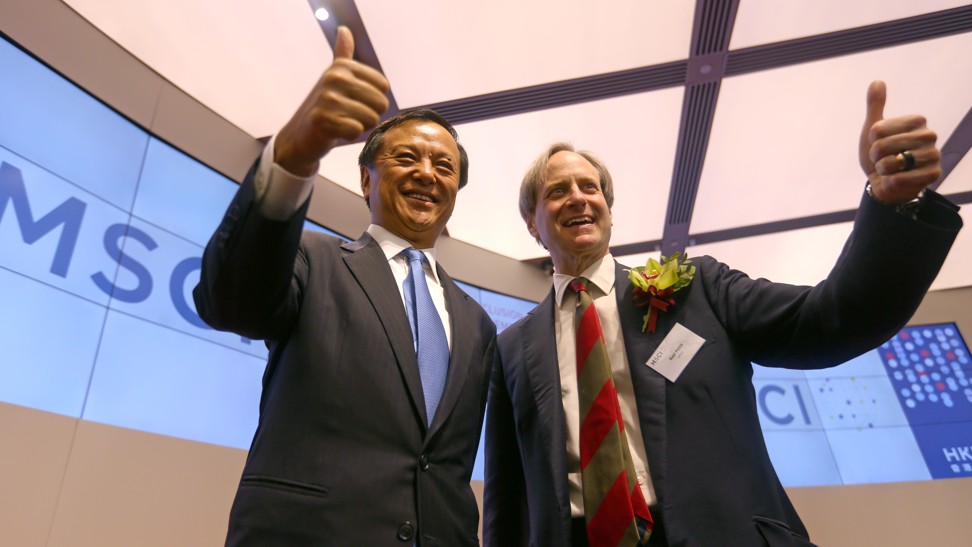
The inclusion of China’s yuan bonds in global bond index is the start of a game-changing shift in global investment patterns
- On April 1, yuan-denominated bonds issued by China’s government and policy banks will be included in the Bloomberg Barclays Global Aggregate Index, tracked by US$2.5 trillion of assets under management
- Inclusion in global indices gives global asset managers benchmarks for tracking their performance
In 1980, sponsors of China’s Yizheng Chemical Fibers desperately needed capital to build a large-scale chemical fibre plant.
State-owned financial institutions were unable to help. Having nowhere else to turn onshore, Yizheng issued a US$50 million bond overseas to raise funds, becoming the first Chinese enterprise in the modern era to tap the international bond market.
Nearly 40 years on, Chinese issuers don’t have to venture overseas to attract foreign capital; investors are coming to China.
For decades, overseas investing in China was considered a complex and tightly controlled affair, something that many thought was best left for tomorrow, not today. China’s bond and equity markets may be the third- and second-largest in the world, respectively, but international participation remains low, at only 2.4 per cent of domestic bonds and around 7 per cent of freely traded A shares.
But a series of reforms has changed the picture in recent years – and tomorrow has come. More and easier avenues have opened up for foreign investors. Chinese bonds and equities are being included in major global indices. Slowly but surely, China’s capital markets are moving into the global investment mainstream.
Last year alone, international investors bought more than US$81 billion of Chinese bonds, making the country the largest recipient of foreign investment among emerging bond markets globally. HSBC Global Research expects another US$150 billion to follow over time – and an additional US$600 billion to head into Chinese stocks in the next five to 10 years.

The scale of these inflows speaks volumes about the changes that are taking place in China’s capital markets – and about why investors from Birmingham to Boston to Berlin need to be ready.
Inclusion in global indices means asset managers around the world who use these benchmarks to invest savings and public money on behalf of pension plans, sovereign wealth funds and insurance companies will need to start buying the Chinese bonds and equities if they want to track the performance of those indices.
The next milestone comes on April 1, when renminbi-denominated bonds issued by China’s government and policy banks will start to be included in the Bloomberg Barclays Global Aggregate Index. Tracked by around US$2.5 trillion of assets under management, ‘Global Agg’ is one of the world’s most important bond indices.
Bloomberg to include yuan-denominated, Chinese government bonds in its benchmark indices
This marks the beginning of game-changing shifts in the overall investment patterns globally.
For asset managers and ordinary savers around the world, the change means exposure to a market that only began opening up to the outside world a decade or so ago, and that, despite its massive size (US$12 trillion) and yields that compare favourably to those in low-interest rate economies like the US, Japan and Europe, is still under-represented in global investment portfolios.
It also gives investors a stake in an economy whose shift towards higher-tech and more consumption and services-oriented growth is swelling the ranks of the middle classes and creating promising corporate stories across an array of sectors.
True, economic growth has slowed from the double-digit pace of a few years ago, but 6.6 per cent expansion last year added roughly the equivalent of Spain’s or Australia’s economy to China’s GDP in 2018.
China’s policymakers recognise that opening up the capital markets to more foreign participation can be instrumental in continuing the growth story, helping to diversify the sources of capital available to domestic enterprises and supporting a gradual but important transition of long-term financing from banks to capital markets.
In other words, reforms aimed at simplifying international access to its markets are very much in China’s own interests – and will continue – global trade tensions notwithstanding.
Progress has already been made. In the bond markets alone, the China Interbank Bond Market Direct programme was launched in 2016, and a Bond Connect link with Hong Kong launched in 2017, allowing global investors to access the mainland market.
In line with China’s approach to reform and opening over the last 40 years, the liberalisation of its capital markets will be a gradual process. Investors have questions about liquidity, their ability to value their portfolios, the regulatory approach, credit ratings and default risks.
They will naturally need time to become familiar with a new market. But the commitment China has already demonstrated to opening up its capital markets should give them confidence for the future.
So it would be a mistake to overlook the potential of a market – and an economy – that is going through a historic transformation.
Investors who do the work now stand to reap benefits for years to come – and so will China.
David Liao is president and chief executive officer of HSBC China

